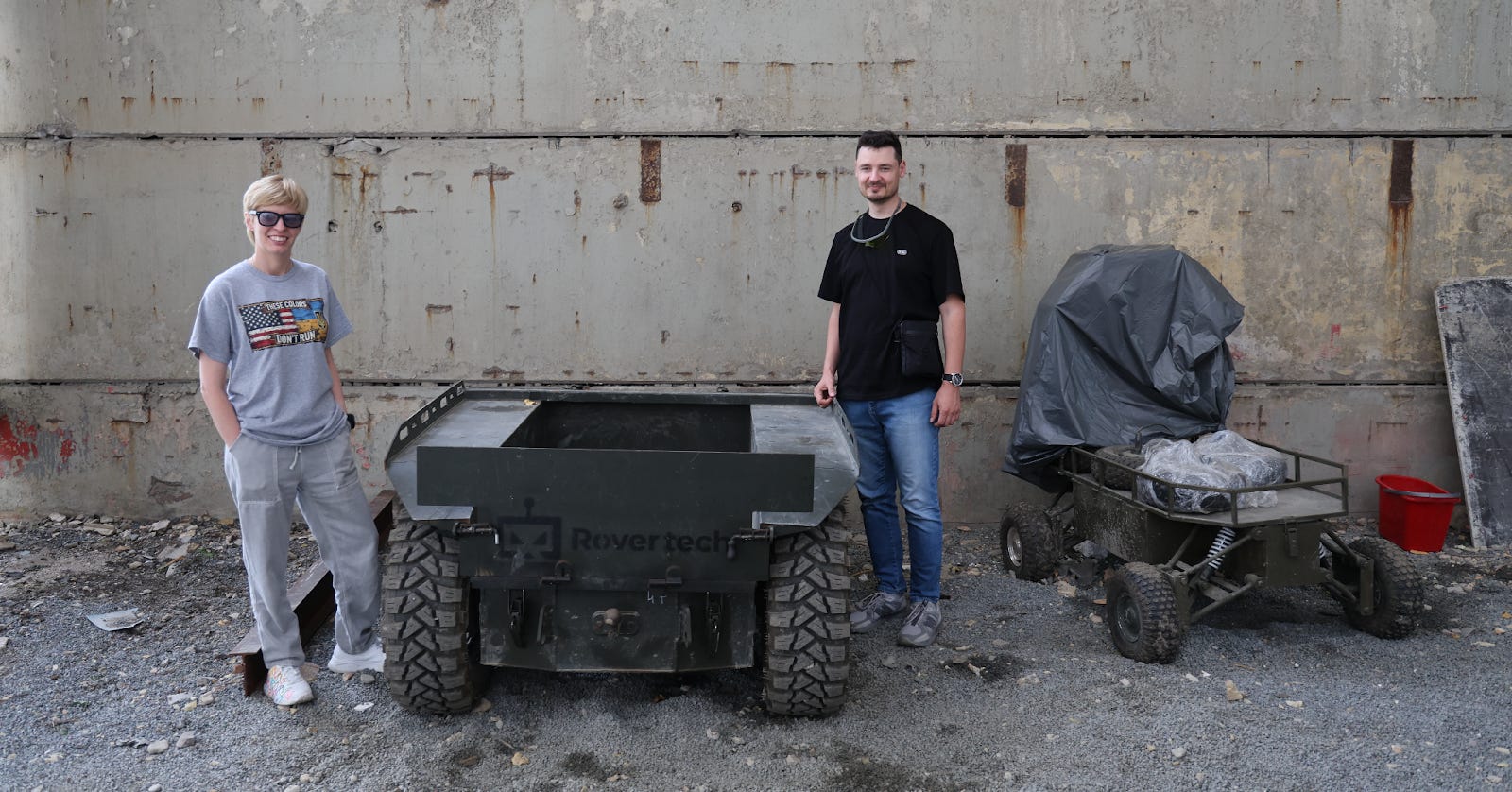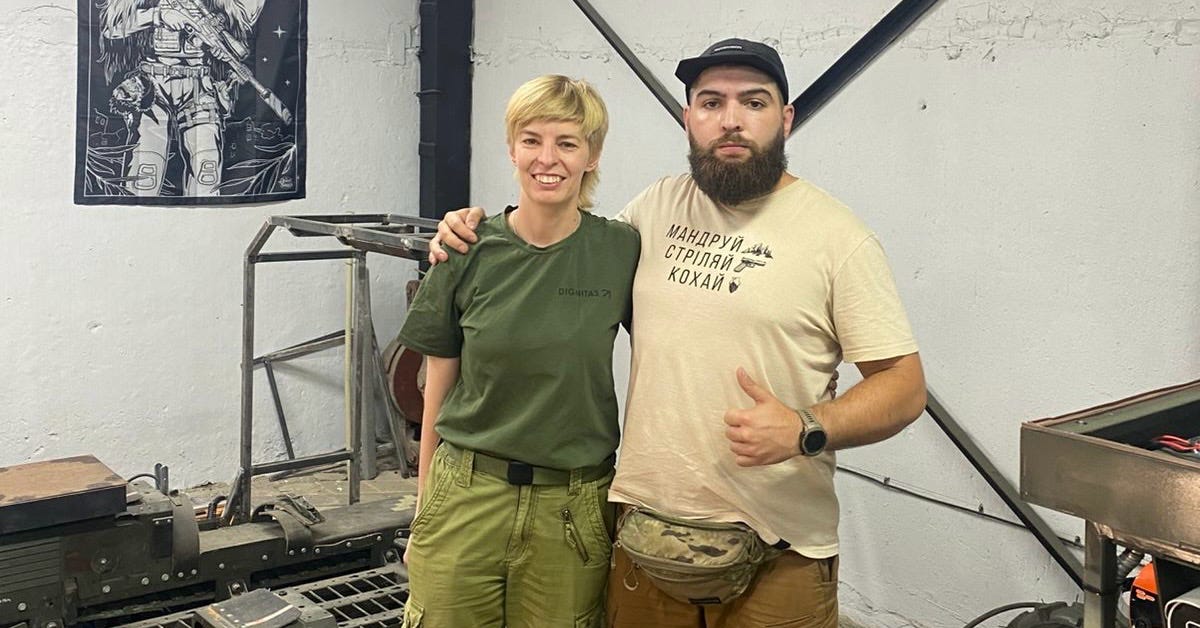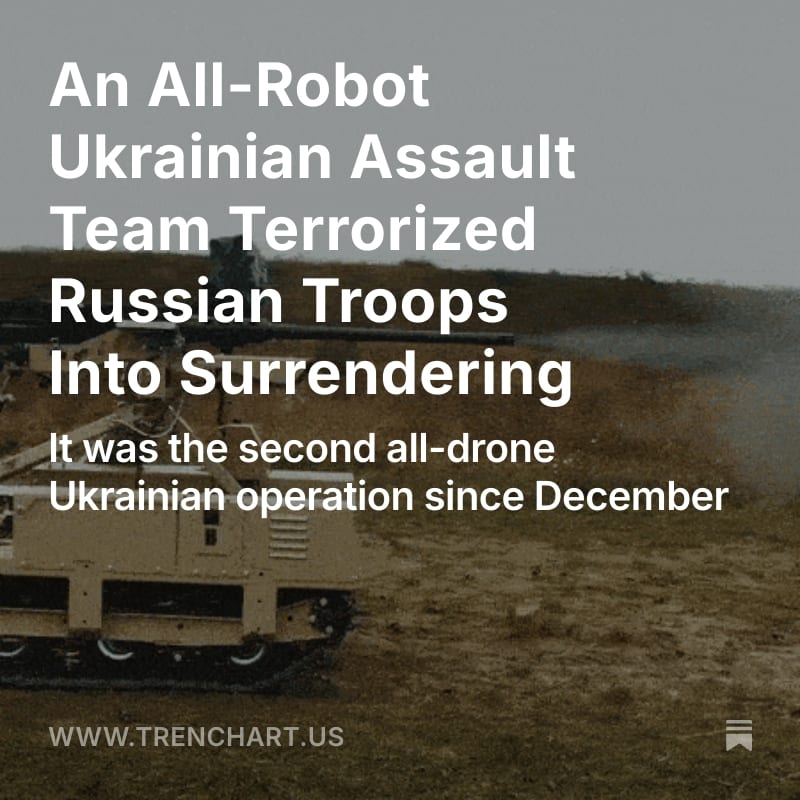Meet the Tech Nerd Talking Stubborn Ukrainian Commanders Into Using More Ground Robots
Lyuba Shipovich makes a compelling argument to a manpower-starved army
This is a special one, folks—a dispatch from the front line in Ukraine by roving war correspondent David Kirichenko. Support David’s dangerous work by subscribing to Trench Art. The revenue from all subs to this story go straight to David.

by DAVID KIRICHENKO
Lyuba Shipovich, a software engineer and entrepreneur, was running a tech company in New York City when Russia widened its war on Ukraine in February 2022.
Shipovich returned home to join the resistance. In 2023, she founded Dignitas, a nonprofit dedicated to training soldiers and integrating cutting-edge technologies with Ukraine’s military operations.
Shipovich spearheaded Victory Drones, which helped drone operators scale up their activities across Ukraine’s armed forces. Now, she’s turning her focus to ground robotics—working to ensure Ukraine’s military can deploy unmanned ground systems across the front line.
Their latest initiative is Victory Robots. “It’s all about giving Ukraine every possible advantage to win—while protecting lives and reducing human losses,” the team wrote in a June social media post.
After years of grinding warfare, Ukraine is facing a serious manpower shortage. Russia, with a population more than three times larger and a sprawling oil and gas industry, can offer higher pay to attract new recruits—lending it a significant mobilization advantage.
Russia can afford to send wave after wave of soldiers to die on Ukrainian soil. By contrast, Ukraine must turn to technology. But getting this tech to the front is far from simple. Resistance persists, particularly among Soviet-trained officers who often struggle to understand or trust these new capabilities.
This is where Shipovich comes in. Every month, she travels to brigades across the front. She listens to commanders, identifies their pain points and finds ways to support their deployment of ground robots.
“We train the military on tech, provide them with tech and push for systemic adoption of battlefield innovation,” Shipovich said.
“We’re different from traditional charities, as we don’t just fundraise and donate gear,” she added. “We build and test solutions, prove their value—and then advocate for government adoption.”
Last month, I had the opportunity to join Shipovich and Stepan Nehoda from Dignitas as they visited some brigades. At each base we visited, every commander was eager to speak with her. “The people we work with love us,” Shipovich. But “some officers hate us because we push them to do more work.”
I was told that Shipovich has the ability to influence the General Staff of the Ukrainian Army—and that she plays a role in shaping planning and resource allocation at the highest levels.
Improvising
Each brigade’s robotics unit was quick to show off their own homemade battlefield tools—the tech they’d built in garages and workshops.
Operators from the 3rd Assault Brigade told me they’re using ground robots for medical evacuations almost every day. Other units are relying on robots to handle more of the logistical burden—delivering supplies and reducing the risks to human soldiers.
Oleksandr, the platoon commander overseeing ground robots for the Antares Battalion of the Rubizh Brigade, described how volunteers are helping Ukraine adapt on the battlefield. “Volunteers like Dignitas serve as a bridge between tech developers and the military,” he said. “They help rapidly test new solutions, adapt them to real battlefield conditions and quickly deliver what actually works to the front lines.”
“This isn’t just humanitarian support,” he added. “It’s the real-time development of combat capabilities.”
“Ground robotic platforms are already proving their effectiveness in logistics, evacuation and fire support,” Oleksandr said. “Over the next year, their role will only grow. They reduce risks for personnel, automate routine or dangerous tasks and enhance the overall tactical flexibility of units.”
“This is no longer science fiction,” he said. “It’s a tool of war.”
Technological leap
One recent operation showed just how far the technology has come. In the Kharkiv region recently, soldiers from the 3rd Assault Brigade carried out a successful mission without a single infantryman on the ground.
Using only first-person-view drones and ground robots, they attacked enemy positions, destroyed fortifications and captured Russian soldiers … who surrendered to the machines.
The remaining troops were guided by drones to Ukrainian forces and taken prisoner. “This is the first confirmed successful assault in modern warfare conducted exclusively by unmanned platforms,” the 3rd Assault Brigade noted.
At a recent demonstration of robotic systems near Kyiv, Volodymyr Rovensky, an officer in the Department for the Development of Ground Control Systems for Unmanned Systems under the Land Forces Command of the Armed Forces of Ukraine, provided a broader view. He noted that 22 combat units are already deploying ground robots.
According to Rovensky, 47% of all missions carried out by these systems involve logistics and evacuation, 25% are engineering tasks, 12% are combat operations and the rest are special tasks. He emphasized that technological superiority will determine the next phase of the war.
“Our primary task,” Rovensky said, “is to provide the army with robotic complexes that can replace the infantry.”
“The idea that robots can fully replace infantry is both true and false,” Shipovich said. “Today, they cannot, but that should be our goal.”
“We must get people out of the trenches and off the front line,” she added. “Robots can do the dirty, dangerous work.”
Ukraine leads the way
“Today, 99% of ground drones in military use are Ukrainian-made,” Shipovich said. “Other countries are studying our approach because what worked in U.S. labs or fields is not viable in war. Ukrainian engineers are creating the future of warfare, not just for Ukraine, but for the world.”
Shipovich also spends a lot of time thinking about artificial intelligence and how to apply it more widely across the battlefield—including integrating it with ground robots to make the ’bots even more effective.
“Techology is everything,” she told me. When asked what she plans to do once the war is over, she said she needs to survive it first.





